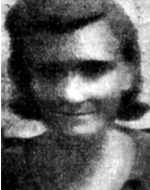Zippora, daughter of Regina and Chaim-Israel, was born on 4 August 1927 in Czechoslovakia, in the village of Durobertovo in Transcarpathian Ukraine, and grew up in a religious elementary school, In 1939, on the eve of the outbreak of World War II, Hungary gained control of it and the fate of the Jews was the same as that of their brethren throughout Hungary: the men were recruited to the “Labor Service” battalions Of the Hungarian army, and many others were, in the following months, among the first deported to Auschwitz until the German occupation of Germany In March 1944 some of the Carpathian Jews managed to maintain a normal life, and even aided Jews who fled from Poland and Slovakia, after which most of them were deported to the extermination camps, and by the end of the war about 80 percent of the 75,000 Jews living in Transcarpathia had been exterminated. She was able to survive the horrors of the place, and from there she was transferred to the Terezin concentration camp in Czechoslovakia, where she worked in the bakery and tried to supply bread to the starving Jews. Terezin was intended to be a “model Jewish settlement,” and thus the Germans sought to disguise the extermination of the Jews of Europe. At the end of April 1945, the German authorities transferred to Theresienstadt thousands of prisoners who had been evacuated from the concentration camps on the eve of their liberation by the Allied armies. Their entry caused epidemics, in which many died. Zippora was liberated from the Theresienstadt camp on May 8, 1945. When she returned to her native village she found the house empty and desolate. She moved to Budapest, the capital of Hungary, joined the “Drora” group of the Gordonia movement, but remained faithful to its religious education and carried out the commandments in all its ways. From Budapest she came to Graz, Austria. She was one of the first to steal the border to Italy, and in October 1945 immigrated to Eretz Israel on the illegal immigration ship “Enzo Sereni”. In the country, Zippora separated from her group, and in January 1946 she joined Kfar Etzion in the Hebron Hills, the first of the Gush Etzion settlements. She was quiet and devoted to work, was absorbed into society and tried to integrate into Hebrew and its culture. According to the United Nations Partition Plan of November 29, 1947, the Etzion bloc was not included in the Jewish state, and immediately after the attack on Gush Etzion and the roads from Jerusalem, “Brigade No. 6, the” Jerusalem “Brigade The Haganah reinforced the Gush with more fighters from the Harel Brigade of the Palmach and from the Field Corps from Jerusalem and Tel Aviv.In the six months of the campaign, Gush Etzion was under siege , Was cut off from Jerusalem and other Jewish settlements and became an isolated island of Jewish settlement in Mount Hebron, and the connection with the Gush was preserved thanks to a number of vehicles that broke through to Miro Especially during the first months of the blockade and with the help of British security, and thanks to a few light planes that made use of an improvised landing site at the site, The Arab Legion “) in a fierce attack before the end of the Mandate and the departure of the British from the Land of Israel, and on May 12, 1948, soldiers of the Legion launched a powerful attack on the block’s strongholds, armed with armored vehicles and artillery. On the following day, 4 May 1948, the Legion forces broke through the fortifications of the village, including the village women,They took refuge in the shelter, under the German convent building – the headquarters – where they served as paramedics. The enemy could not penetrate the shelter and therefore blew the building on its occupants, who were buried under the rubble. Zippora was among the more than one hundred village defenders who fell that day. Many of them were murdered after they surrendered. The next day, on May 14, 1948, the day of the declaration of the state, the defenders of the other three Gush Etzion settlements: Revadim, Masuot Yitzhak and Ein Zurim surrendered, and the remnants of his defenders went to captivity in Jordan. And their remains were collected in 1949 by a special operation of the military rabbinate and brought to eternal rest in a mass grave on Mount Herzl in Jerusalem at a state ceremony held on the 17th of November, 1949. The space is “Last Netzer.” The last survivor of the Holocaust is Holocaust survivors who remained the last remnant of their nuclear family (parents, brothers, sisters, sons and daughters), who experienced The Holocaust in the ghettos and / or the concentration and extermination camps and / or their escape and / or hiding in territories occupied by the Nazis and / or fighting alongside underground or partisan members in the Nazi occupied territories during or after World War II,
